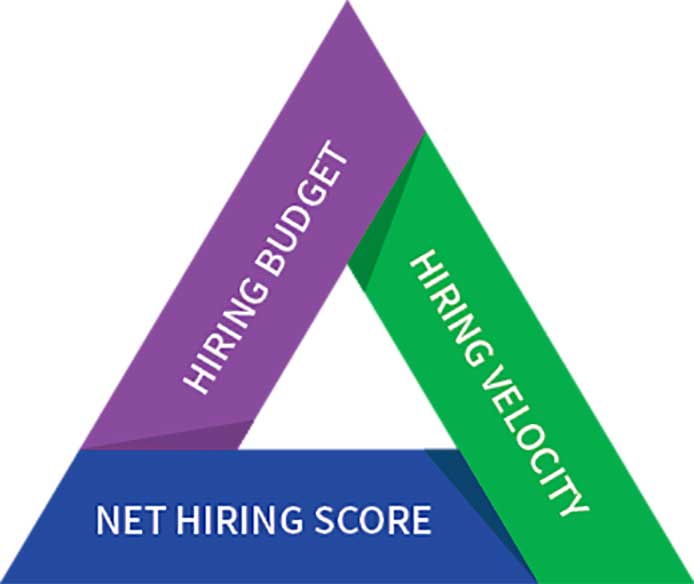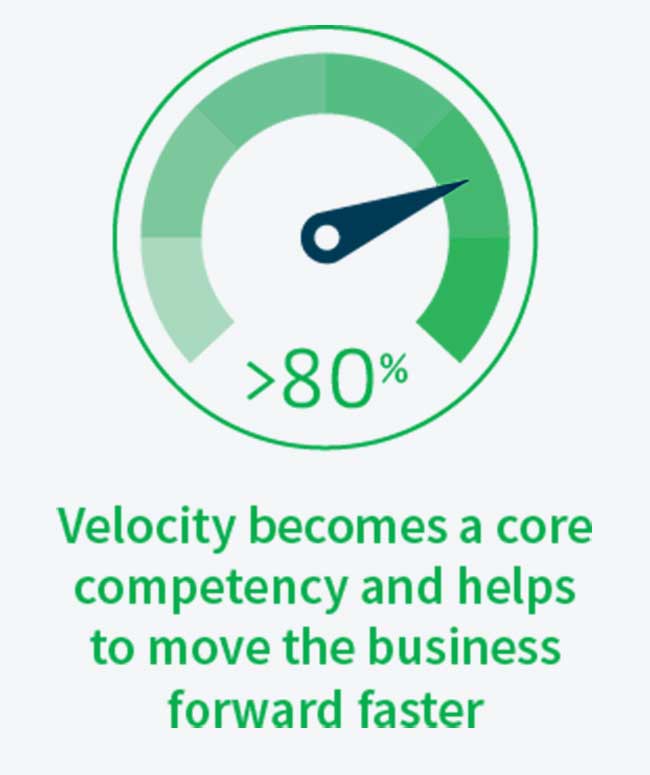Continue Reading
How to Measure Hiring Success:Metrics and Scorecard

Recruiting has historically been measured by static metrics like cost per hire and time-to-hire. These metrics are about faster and cheaper outcomes and result in reactive recruiting strategies. But if hiring is success, then the metrics need to be strategic, and traditional recruiting metrics fail to measure the outcome that hiring choices have on organizations. What organizations need to do, then, is to focus on strategic metrics that drive future decision making in order to out-hire their competitors.
At SmartRecruiters, we call these new measurements the Hiring Success metrics. They are intuitive, impactful benchmarks that resonate strongly with executive leadership. The Hiring Success metrics build upon—and substantially improve—the familiar cornerstones of the project management triangle: cost (Hiring Budget), speed (Hiring Velocity) and quality (Net Hiring Score).
Hiring Budget
While most organizations measure the absolute cost of recruiting, forward-looking organizations consider costs associated with recruiting as an investment—just like a marketing budget—to attract and nurture a pipeline of ideal candidates.
The Hiring Budget is the sum total of recruiting costs associated with hiring new candidates, as a percentage of the total salary of the new employees or new hire payroll. The Hiring Budget frames the costs of recruiting to value of the employee (salary), akin to customer acquisition cost. An organization’s Hiring Budget includes all recruiting costs, including all talent acquisition employees, job advertising, program spend, external recruiters, travel costs of candidates, and technology infrastructure. With Hiring Budget, you can tailor your recruiting investment to the type of role for which you’re trying to hire.

Leading organizations invest, on average and depending on industry, between 5% to 20% in their Hiring Budget. This is a good range to land in, and to understand where an organization stands compared to the investment of their peers.
So why replace cost per hire? After all, it’s easy to quantify and control, and it lures businesses into thinking they are doing something positive by saving money. Unfortunately, the cost per hire metric does not provide you with strategic and actionable insight. Knowing your cost per hire as a static amount won’t tell you if you are investing enough in acquiring top-tier talent or if you need to change your approach.
Furthermore, cost per hire does not account for the fact that the investment necessary to fill roles will vary depending on function, seniority, and other related factors. High-impact niche roles, for instance, may be more expensive to fill and often require a different strategy altogether. If your business plans on investing in the sustainable growth of employee talent, reporting on the cost per hire isn’t helpful as it doesn’t consider long-term impact.
Hiring Velocity
Another key to achieving Hiring Success is the recruiting team’s ability to quickly mobilize and deliver results. Being able to hire new employees when you need them is essential to helping your business grow. Unfortunately, most organizations think of recruiting speed in a vacuum without anchoring it to the company’s goals and forecasts.
Hiring Velocity measures one simple thing: the percentage of jobs filled on time. Why is this important? Well, it answers one simple question: Are we able to hire the people we need when we need them? With Hiring Velocity, CEOs and their executive team can accurately plan and forecast their ability to meet company growth targets.
Hiring Velocity is highly correlated to Business Velocity. Consider the diagram below: a Hiring Velocity of 50% means you’re only able to fill half of your jobs on time. This means you don’t have nearly enough people in the organization to help execute strategy and meet targets.

At 80% or greater, velocity becomes a core competency and moves the business forward faster. In this sense, hiring on time can have a significant impact on the business.
Tracking time-to-fill will incentivize recruiting teams to hire faster, but it only provides one-dimensional insights. In other words, time-to-fill doesn’t show whether the cadence of existing hiring process are actually helping the company meet its goals. Similar to cost per hire, time-to-fill doesn’t take into consideration that the requisite resources to fill a position—in this instance time— vary depending on the role.
Imagine for a moment that your company’s C-suite executives inform you that the company will be investing in building a new core-product feature that will require additional headcount. You will need to hire a team of 15 engineers to build the product—and no less. Additionally, the C-suite says they want a fully functioning team up and ready within 8 months so that they can beat the competition.
You look at your recruiting dashboard and see that your organization’s time-to-fill is six months. Based on this data, you are confident that you can get the job done on time. Now let’s imagine this is how your hiring process plays out:

In this scenario, you filled all your positions with an average time to fill of 6 months, just as expected. However, in reality, you were unable to get the job done on time—you only hired 67% (10/15) of your team on time.
In instances like these, time-to-fill won’t matter to the C-suite. Rather, your performance will be measured on whether or not you were able to meet an agreed-upon deadline.
Had you known your Hiring Velocity for similar roles ahead of time, you could have accurately predicted your ability to hire a fully functioning team of engineers within six months, allowing the C-suite to plan and build contingencies accordingly.
Net Hiring Score
There is no better determinant of a company’s overall hiring success than fit because it naturally reflects the hiring manager’s assessment of a new hire’s aptitude, attitude, and potential immediately after their ramp-up period, as well as the new hire’s assessment of new job responsibilities, management, and company culture. Most organizations ultimately seek to measure quality of hire as a performance metric, but find it difficult to attribute to talent acquisition for two reasons:
- Quality is typically measured through year-end performance reviews, which come far after the hiring process is already completed.
- There is no robust industry standard or methodology to measure quality quickly after a new hire is made.
At SmartRecruiters, we recommend that organizations start to measure their Net Hiring Score (NHS). Similar to the Net Promoter Score (NPS), which measures customer experience, the NHS measures the fit between new hires and jobs. Use it as a pulse metric and when done often, it shows how the TA function is doing in finding the right people for job opportunities. Take the following steps to determine your NHS:
- Ask hiring managers the following question after new hire ramp-up time: On a scale of 0-10, how much of a fit is this new hire for the job?
- Ask new hires the following question after ramp-up time: On a scale of 0-10, how much of a fit is this new job for you?

3. Gather all results and categorize into the percentage of those who answered 9-10 (Great fits) and subtract from it the percentage of those who answered 0-6 (Poor fits). Multiply this result by 100 to land on your NHS.

Your NHS will range from -100 to +100. The higher the score, the better. A benchmark of ramp-up time for knowledge workers can be set at 90 days post-start date, while a low-skill job can be set at 15 days post-start date.
